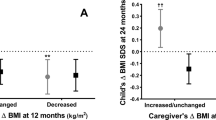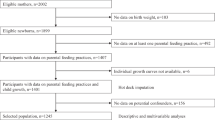Abstract
Objective
Though overweight is often established by school entry, not all mothers of such children report weight concerns. Enhancing concern might assist lifestyle change, but could lead to child body dissatisfaction. We investigated (i) perceived/desired body size and body dissatisfaction in mothers and their 6.5-year-old children, and (ii) the impact of earlier maternal concern about overweight on children's body mass index (BMI) status and body dissatisfaction.
Design
Prospective community study.
Setting
Melbourne, Australia.
Subjects
317 mother–child dyads.
Main exposures
Child and maternal BMI (kg m−2) at 4.0 and 6.5 years; maternal concern about child overweight at 4.0 years.
Outcome measures
Paired perceived and desired body size on 7-point figural rating scales self-reported by mothers and children, and reported by mothers regarding children; dissatisfaction (‘desired’ minus ‘perceived’) score.
Results
For all three actual BMI perceived size pairings (mother self-report, mother's report on child and child self-report), BMI correlated with perceived body size (r=0.82 (mother self-report); r=0.65 (mother reporting on child); r=0.22 (child self-report); all P<0.001). Similarly, all three dissatisfaction scores were greater with increasing BMI status. Children's own dissatisfaction scores correlated with their actual BMI, but were not related to mothers’ own body dissatisfaction scores or with mothers’ dissatisfaction with children's body size. Maternal concern about overweight at the age of 4 years was not associated with BMI change, or child body dissatisfaction by the age of 6.5. Most mothers of overweight and obese children (88 and 90%, respectively) regarded their child as the middle figure (that is, 4) or thinner.
Conclusions
Despite low rates of recognition of child overweight, maternal perceptions of the child's body correlated strongly with the child's actual BMI. Maternal concerns about child BMI did not appear to impact on child BMI change or child body dissatisfaction.
This is a preview of subscription content, access via your institution
Access options
Subscribe to this journal
Receive 12 print issues and online access
$259.00 per year
only $21.58 per issue
Buy this article
- Purchase on Springer Link
- Instant access to full article PDF
Prices may be subject to local taxes which are calculated during checkout

Similar content being viewed by others
References
Rudolf MC, Sahota P, Barth JH, Walker J . Increasing prevalence of obesity in primary school children: cohort study. BMJ 2001; 322: 1094–1095.
Ogden CL, Carroll MD, Curtin LR, McDowell MA, Tabak CJ, Flegal KM . Prevalence of overweight and obesity in the United States, 1999–2004. JAMA 2006; 292: 1549–1555.
Popkin BM . Global nutrition dynamics: the world is shifting rapidly toward a diet linked with noncommunicable diseases. Am J Clin Nutr 2006; 84: 289–298.
Booth ML, Chey T, Wake M, Norton K, Hesketh K, Dollman J . Change in the prevalence of overweight and obesity among young Australians, 1969–1997. Am J Clin Nutr 2003; 77: 29–36.
Neumark-Szatainer D . Can we simultaneously work toward the prevention of obesity and eating disorders in children and adolescents? Int J Eat Disord 2005; 38: 220–227.
Taylor RJ, Smith BH, van Teijlingen ER . Theories of Health Promotion. Health and Illness in the Community. Oxford University Press: New York, 2003; 123–126.
Jeffery AN, Voss LD, Metcalf BS, Alba S, Wilkin TJ . Parents’ awareness of overweight in themselves and their children: cross sectional study within a cohort (EarlyBird 21). BMJ 2006; 330: 23–24.
Eckstein KC, Mikhail LM, Ariza AJ, Thomson JS, Millard SC, Binns HJ . Parents’ perceptions of their child's weight and health. Pediatrics 2006; 117: 681–690.
Baughum AE, Chamberlin LA, Deeks CM, Powers SW, Whitaker RC . Maternal perceptions of overweight in preschool children. Pediatrics 2000; 106: 1380–1386.
Carnell S, Edwards C, Crocker H, Boniface D, Wardle J . Parental perceptions of overweight in 3–5 year olds. Int J Obes 2005; 29: 353–355.
Maynard LM, Galuska DA, Blanck HM, Serdula MK . Maternal perceptions of weight status of children. Pediatrics 2003; 111: 1226–1237.
Campbell MW, Williams J, Hampton A, Wake M . Maternal concern and perceptions of overweight in Australian pre-school-aged children. Med J Aust 2006; 184: 274–277.
Collins ME . Body figure perceptions and preferences among preadolescent children. Int J Eat Disord 1991; 10: 199–208.
Williamson S, Delin C . Young children's figural selections: accuracy of reporting and body size dissatisfaction. Int J Eat Disord 2001; 29: 80–84.
Truby H, Paxton SJ . Development of the children's body image scale. Br J Clin Psychol 2002; 41: 185–203.
Krahnstoever-Davison KK, Lipps Birch LL . Weight status, parent reaction and self-concept in five-year-old girls. Pediatrics 2001; 107: 46–53.
The Parent Education and Support (PEAS) Program: final report. Centre for community child health, royal children's hospital. Available at http://hnb.dhs.vic.gov.au/commcare/ccdnav.nsf/fid/ Accessed 2003.
Stunkard AJ, Sorensen T, Schulsinger F . Use of the Danish adoption register for the study of obesity and thinness. In: Kety SS, Rowland LP, Sidman RL, Matthysse SW (eds). Genetics of Neurological and Psychiatric Disorders. Raven Press: New York, 1983, pp 115–120.
National Health Data Committee 2003. National Health Data Dictionary Version 12. Australian Institute of Health and Welfare: Canberra, 2003. (AIHW Cat. No HWI 43).
Cole TJ . Growth monitoring with the British 1990 growth reference. Arch Dis Child 1997; 76: 47–49.
Vidmar S, Carlin J, Hesketh K, Cole T . Standardizing anthropometric measures in children and adolescents with new functions for egen [computer program]. Stata J 2004; 4: 50–55. Available at: http://www.stata-journal.com/abstracts/dm0004.pdf.
Cole TJ, Bellizzi MC, Flegal KM, Dietz WH . Establishing a standard definition for child overweight and obesity worldwide: international survey. BMJ 2000; 320: 1240–1243.
Rowland ML . Self reported weight and height. Am J Clin Nutr 1990; 52: 1125–1133.
Australian Bureau of Statistics, Commonwealth of Australia. Socio-Economic Indexes for Areas (SEIFA) Volume 1.1. Australian Bureau of Statistics: Canberra, Australia, 2001.
Lord FM . A paradox in the interpretation of group comparisons. Psychol Bull 1967; 68: 304–305.
Acknowledgements
This paper draws on data from a larger longitudinal study, the PEAS Kids Growth Study. RM worked on and MW supervised all phases of the work leading to this paper; MW founded the PEAS Study, and has been a Chief Investigator in all phases; LC conducted all statistical analyses and prepared the tables; JW was the Principal Investigator for the PEAS Kids Growth Study (4.0- to 6.5-year-old waves) and advised on the paper. RM, MW and LC co-wrote and JW edited the paper. We thank all the parents and children who took part in the study, and the research assistants who assisted with data collection. We also acknowledge the major role of Dr Michele Campbell (PhD student) in the 4.0- to -6.5-year-old wave of the PEAS Kids Growth Study.
Author information
Authors and Affiliations
Corresponding author
Additional information
Financial Disclosures:
The PEAS Kids Growth Study 4.0- to -6.5-year-old waves were funded by the Australian National Health and Medical Research Council (NHMRC Project Grant 284509) and the Murdoch Childrens Research Institute. Dr Wake's salary is part-funded by NHMRC Population Health Career Development Award no. 284556. There are no competing interests.
Rights and permissions
About this article
Cite this article
Mitchell, R., Wake, M., Canterford, L. et al. Does maternal concern about children's weight affect children's body size perception at the age of 6.5?—A community-based study. Int J Obes 32, 1001–1007 (2008). https://doi.org/10.1038/ijo.2008.12
Received:
Revised:
Accepted:
Published:
Issue Date:
DOI: https://doi.org/10.1038/ijo.2008.12



